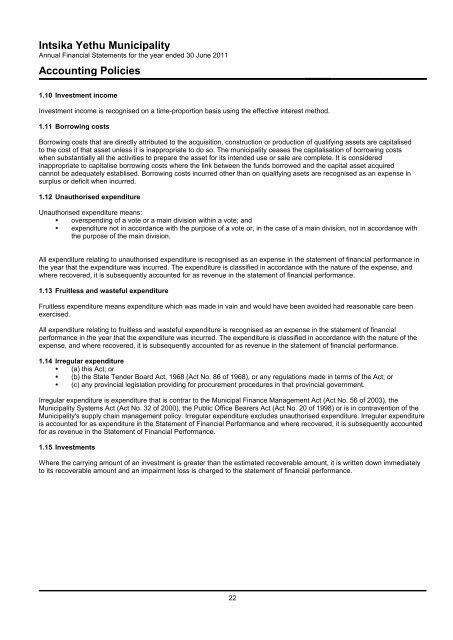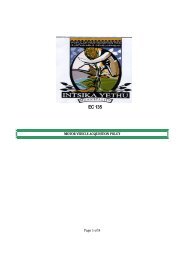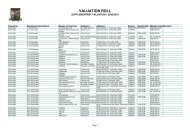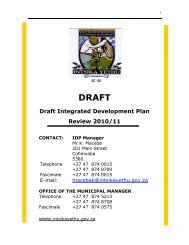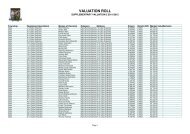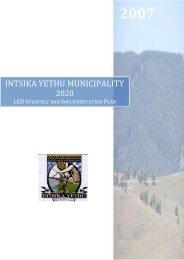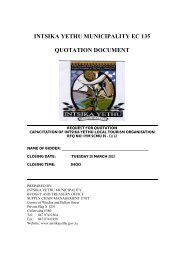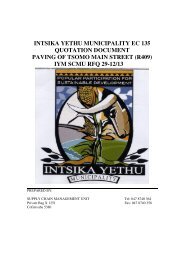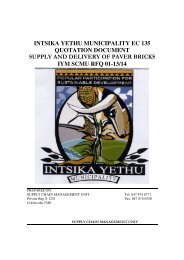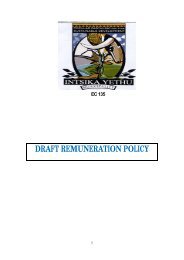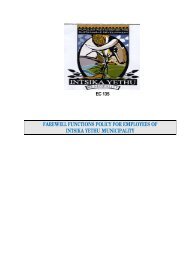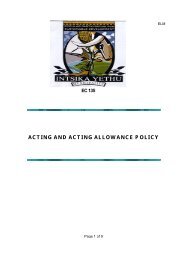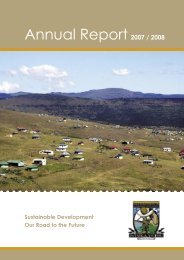annual report 2010 - 2011 - Intsika Yethu Municipality
annual report 2010 - 2011 - Intsika Yethu Municipality
annual report 2010 - 2011 - Intsika Yethu Municipality
Create successful ePaper yourself
Turn your PDF publications into a flip-book with our unique Google optimized e-Paper software.
<strong>Intsika</strong> <strong>Yethu</strong> <strong>Municipality</strong><br />
Annual Financial Statements for the year ended 30 June <strong>2011</strong><br />
Accounting Policies<br />
1.10 Investment income<br />
Investment income is recognised on a time-proportion basis using the effective interest method.<br />
1.11 Borrowing costs<br />
Borrowing costs that are directly attributed to the acquisition, construction or production of qualifying assets are capitalised<br />
to the cost of that asset unless it is inappropriate to do so. The municipality ceases the capitalisation of borrowing costs<br />
when substantially all the activities to prepare the asset for its intended use or sale are complete. It is considered<br />
inappropriate to capitalise borrowing costs where the link between the funds borrowed and the capital asset acquired<br />
cannot be adequately establised. Borrowing costs incurred other than on qualifying asets are recognised as an expense in<br />
surplus or deficit when incurred.<br />
1.12 Unauthorised expenditure<br />
Unauthorised expenditure means:<br />
overspending of a vote or a main division within a vote; and<br />
expenditure not in accordance with the purpose of a vote or, in the case of a main division, not in accordance with<br />
the purpose of the main division.<br />
All expenditure relating to unauthorised expenditure is recognised as an expense in the statement of financial performance in<br />
the year that the expenditure was incurred. The expenditure is classified in accordance with the nature of the expense, and<br />
where recovered, it is subsequently accounted for as revenue in the statement of financial performance.<br />
1.13 Fruitless and wasteful expenditure<br />
Fruitless expenditure means expenditure which was made in vain and would have been avoided had reasonable care been<br />
exercised.<br />
All expenditure relating to fruitless and wasteful expenditure is recognised as an expense in the statement of financial<br />
performance in the year that the expenditure was incurred. The expenditure is classified in accordance with the nature of the<br />
expense, and where recovered, it is subsequently accounted for as revenue in the statement of financial performance.<br />
1.14 Irregular expenditure<br />
(a) this Act; or<br />
(b) the State Tender Board Act, 1968 (Act No. 86 of 1968), or any regulations made in terms of the Act; or<br />
(c) any provincial legislation providing for procurement procedures in that provincial government.<br />
Irregular expenditure is expenditure that is contrar to the Municipal Finance Management Act (Act No. 56 of 2003), the<br />
<strong>Municipality</strong> Systems Act (Act No. 32 of 2000), the Public Office Bearers Act (Act No. 20 of 1998) or is in contravention of the<br />
<strong>Municipality</strong>'s supply chain management policy. Irregular expenditure excludes unauthorised expenditure. Irregular expenditure<br />
is accounted for as expenditure in the Statement of Financial Performance and where recovered, it is subsequently accounted<br />
for as revenue in the Statement of Financial Performance.<br />
1.15 Investments<br />
Where the carrying amount of an investment is greater than the estimated recoverable amount, it is written down immediately<br />
to its recoverable amount and an impairment loss is charged to the statement of financial performance.<br />
22


